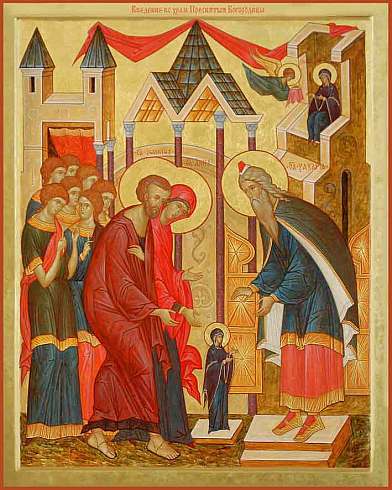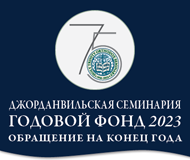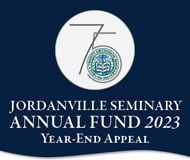News
-

Parish feast in Montreal
29 December 2010
This year, the parish feast of St. Nicholas’ Cathedral in Montreal, celebrated on “Winter St. Nicholas”, December 6/19, fell on Sunday. Guests from the other parishes of our diocese arrived for the all-night vigil on Saturday: for Polyeleos, His Grace, Gabriel, Bishop of Montreal and Canada, was followed not only by the cathedral clergy: the sacristan, protopriest George Lagodich and priest Michael Metni, but also by priest Viatcheslav Davidenko (Trinity cathedral, Toronto, Ontario) and priest Alexey Pjawka (Protection Memorial church, Ottawa, Ontario).
His Grace, Vladyka Gabriel served the Divine Liturgy, along with the above mentioned clergy, together with protodeacon Vasili Milonow, cathedral deacon Boris Sidorenko, and deacon Eugene Schukin, who was ordained to the priesthood after the Great Entrance. Fr. Eugene will have the task of caring for the recently established community of St. Tikhon, the Patriarch of Moscow, the Confessor, in Kitchener, Ontario.
The services were held with a large number of people attending: there were not only local parishioners, but also those, who came to the cathedral in order to share the feast with the Montreal parishioners. The cathedral choir, under the direction of Michael Kreiger-Voinovsky, sang beautifully and movingly.
Priest Viatcheslav Davidenko preached a sermon, and after the dismissal, Vladyka Gabriel address the flock with his archpastoral greeting. After the prayer service before the church icon with the relics of St. Nicholas, and after the chanting of many years, all present were invited to a meal, prepared by the cathedral sisterhood, which is long famous for its hospitality.
Here are some photos from the event in Montreal.
-

St. Herman’s youth conference
10 December 2010
ENCYCLICAL
To All the Reverend Rectors of the Montreal & Canadian Diocese
DIRECTIVE
This year, the St Herman’s Youth conference will be held, with God’s help, at the Holy Trinity Monastery, Jordanville, USA. The St Herman’s youth conference is now in it’s 30th year and continues it’s mission to provide a rare opportunity for all of our Orthodox youth to meet together, to become acquainted, to participate in group discussions and to listen to lectures of a purely Orthodox character, and finally and most importantly, to prepare for and receive communion of the Holy Mysteries of Christ on the feastday of St Herman, 12/25 December.
In connection with this, I urgently request that all the reverend rectors take up a special collection on Sunday, December 6/19 of this year in our parishes at the end of the Divine Liturgy to help defray the costs of organizing this conference. I would also ask that this be announced from the amvon prior to the collection taking place.
The St Herman’s committee which is undertaking the organization of the conference is working very hard to contain the costs of attending these conference to a minimum. As always, the outlays for food and lodging are the highest. For this reason we are appealing to each parish to make this conference accessible to as many of our Orthodox youth as possible.
The funds collected will help to cover the expenses of the conference and will also be used to make it possible for the St Herman’s organizing committee to assist young people from families of limited means.
You may ask why support a conference in the USA when we have our own Canadian needs? To this I will answer, last year when the conference was in Montreal we received most of our support from the USA parishes. We need to contribute generously to help as many of our Canadian youth to attend the conference this year.
I thank you in advance for your support. Please do not forget that our youth is our future. We must support it!
Please send cheques to:
St. Herman’s Youth Conference
c/o Rev. George Lagodich
6738 32 Ave
Montreal, QC H1T 3C9Gabriel
Bishop of Montreal and Canada
November 22/December 5, 2010
-

Entry into the temple of our Most Holy Lady the Theotokos and Ever-Virgin Mary
3 December 2010
Particular details, reflected in the feast – on the the Great Twelve Feasts – of the Entry into the Temple of the young Jerusalem Maiden Maria – the Living Temple, destined to be the New House of God (similarly as also the circumstances of the Nativity of the Theotokos) – we find in one of the ancient memorials of faith of the Palestinian christians: in the so called Protevangelium of James (the Story of James). The study of this book, it reflected in itself the Holy Tradition, confirms that the veneration of the Mother of God was established in the early Church in no way later than the beginning of the second century.
“…The child reached the age of two, and Joachim said: “Take Her into the Temple of the Lord, as the fulfillment of the promise, which we took upon ourselves and must fulfill; in order for the Lord not to requite it from us, and that our gift would not become unacceptable to Him.” And Anna said: “Let us wait for the third year, so as not to tarry the Child with her father and mother.” And when the Child was three years old, Joachim said: “call for the pure virgin Hebrew daughters and give each of them a lamp, and let them light them, and let not the Child turn back, so that Her heart would not turn away from the House of God.” And they did so until they entered the Temple. And the priest met Her, and kissed Her, and blessed Her, saying: “The Lord God will magnify Thy name in all generations; in Thee, in the end of times, the Lord will proclaim the deliverance of the children of Israel.” (Protevangelium of James, 7:1-6; as published by Collins, London, 1980).
Further, the Story of James tells that the young Mary was led to the third step of the temple altar “and the mercy of God was poured out upon Her, and the Child danced for joy”, – on account of the unspeakable joy of meeting with the Spirit of the Lord, – in the same way as, about a decade and a half later, the child rejoiced and leapt in the womb of Elizabeth, the mother of John the Baptist, when the Theotokos and Ever-Virgin Mary, the Temple Not Made with Hands, entered the house of Zacharias and Elizabeth, the parents of the future Forerunner of the Lord (Luke 1:39-45).
Pious tradition adds that the priest, whose duty it was to serve at the time, (some sources state that it was namely Zacharias) by the revelation of God led the three year old Mary into the Holy of Holies of the Jerusalem Temple; this caused not only the people to marvel, but also the Powers of Heaven: “the angels wondered seeing the entry of the Most Pure One: how the Virgin entered the Holy of Holies with glory”. One should remember, the tradition states that the apostle James, the brother of the Lord, to whom the Story of James is ascribed, had the right to see the Holy of Holies.
The maiden Mary was raised at the Jerusalem Temple “as a dove and received food from the hands of angels” – meanwhile, the historical fact that She could have been left to live on holy mount Moriah is supported even by non-christian sources. It is known that there were built thirty three story “stone houses, spacious and beautiful… These houses had rooms for various persons: the virgins lived separately, until the time of consecration for the services to God” (I cite: S.V. Bulgakov. Handbook for the sacred church ministers. Kharkov. 1900).
It is difficult to say when exactly the feast of the Entry into the Temple became a part of the circle of the divine services of the Twelve Feasts. It is only known that the beginning of the celebration is connected with the most famous Jerusalem building of the byzantine times: the Basilica of the Most Holy Theotokos, which was erected on the Temple mount by emperor Justinian in the sixth century A.D. The ruins of this basilica, known by the name of “nea” (new) were found during the excavations in Jerusalem in the first half of the 70s. It is possible that the fourth century historian Procopius mentions “Nea”. Among other things, in the last century, Russian church writer and historian Avraam Sergeyevich Norov talked in the Holy City with the Palestinian Christians, “who to this day point to the Church of the Entry of the Theotokos, which used to be in ancient times, and attribute its building to empress Helena” (See “Travel in the Holy Land in 1835”.).
The consecration of the basilica “Nea” took place in 548 – and gradually, the annual church feast got tied with the corresponding narrative of the Story of James. Nonetheless, even one hundred years after the consecration, the ever-memorable Patriarch of Jerusalem Sophronios, speaking in one of his homilies about the life of the young Mary in the Temple, does not mention the church feast of Her Entry.
In the 638, “Nea” was converted into a mosque. The church feast was no longer celebrated. But specifically from that time, beginning with the second half of the seventh century, the service for the Entry of the Most Holy Theotokos into the Temple began to gain the features of an independent feast.
It is said that the feast came to Constantinople from Jerusalem by the efforts of St. Andrew of Crete, although there is no specific proof of that. In any case, it was specifically at that time that the Patriarch of Constantinople, Herman I, dedicated two homilies to the Entry. It was said in them that the festive Entry services appeared very recently. The homilies of Patriarch Herman are dated in the beginning of the eighth century, and in the next century, stichera of the feast, which are sung to this day, were written by St. Gregory of Nicomedia.
It is curious that the Greek Orthodox Encyclopedia mentions, without any details, some depiction of the young Theotokos, praying on the Temple mount, the depiction being located somewhere in Rome; it is dated in the fifth century.
“The Virgin openly appears in the temple of God and proclaims Christ unto all”, – is said in the troparion of the Entry. “And the entire house of Israel loved Her”, – is said in the Story of James. Yet this is only the preparation for the incarnation of Christ, and today She, the three year old, without turning back, with wondrous ease runs up the high steps to the very altar, – and from this day of the Entry the Church, on the journey to meet the Nativity of Christ, begins to sing: “Christ is born, glorify…”.






